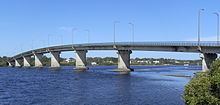No. of spans 9 Opened 6 April 1974 Location Tea Gardens Material Concrete | Clearance below 11 m Total length 304 m Bridge type Girder bridge | |
 | ||
Carries motor vehicles, pedestrians Similar Booti Booti National Park, Wirragulla railway station, Black Bulga State Conserva, The Glen Nature Reserve, Sandgate railway station - N | ||
The Tea Gardens-Hawks Nest Bridge, also known as the Singing Bridge, crosses the Myall River connecting the two townships of Tea Gardens and Hawks Nest in the Mid-Coast Council, New South Wales, Australia. It got its name from the musical sounds the bridge railings generate during strong south-westerly winds causing the bridge to act as a wind harp.
Contents
History
About 1928, a ferry service started carrying passengers and, later, vehicles between the two townships across the Myall River. In peak holiday periods, however, the length of queues reached unacceptable levels of up to six hours waiting time, creating demand for a bridge. The Tea Gardens-Hawks Nest Bridge was completed and opened by the New South Wales Minister for Public Works on 6 April 1974. The building cost of the bridge was A$1.2 million. The bridge was placed immediately downstream of the ferry crossing and then replaced the ferry service.
Details
The Singing Bridge is a girder bridge made of prestressed concrete and normal reinforced concrete with a total length of 304.3 metres (998 ft). It has 7 spans of 35.3 metres (116 ft) length and two spans of 28.3 metres (93 ft) length. It carries a two-lane road 7.3 metres (24 ft) wide and two pedestrian walkways 1.5 metres (5 ft) wide. The bridge has a clearance of 10.6 m (34.8 ft) at high water.
Located at the northeastern end of the bridge is the Jean Shaw Koala Reserve, which is part of a wildlife corridor to the Myall Lakes, and koalas have been recorded crossing the bridge at night.
